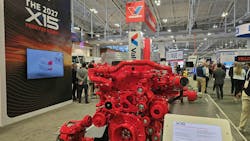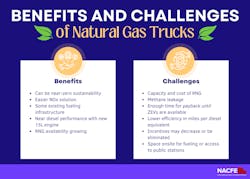With strict emission regulations under fire by the Trump administration, fleets and owner-operators can expect to see more Class 8 trucks powered by internal combustion engines (ICE) this week at the Advanced Clean Transportation Expo in Southern California.
ACT Expo reported that, in addition to record attendance, there will be a dozen Class 8 trucks with ICE powertrains at the Anaheim Convention Center (six natural gas, six diesel) compared to nine Class 8 zero-emission trucks (six all-electric, three hydrogen fuel cell).
But it’s Cummins’ X15N natural gas engine that stands to gain the most attention at the show, highlighting emissions reduction, capability, and refueling opportunities. The engine maker confirmed that six of the ICE trucks at the show are spec’d with the X15N.
“There's going to be more truck companies showing the X15N and natural gas solutions than probably ever before,” said Lawren Markle, director of media relations for ACT Expo. “We've come to a bit of a tipping point here.”
Past coverage of RNG/CNG engines
The X15N-spec'd trucks include Chevron’s Peterbilt 579, which will be available Tuesday and Wednesday at the show’s Ride and Drive. Other trucks equipped with the X15N include Clean Energy’s Peterbilt 579; Daimler Truck North America’s fifth-gen Freightliner Cascadia; Hexagon Agility’s Kenworth T880 with dual ProRail 60 diesel gallon equivalent CNG tanks; Kenworth’s T680; and Penske’s fifth-gen Freightliner Cascadia.
The X15N is Cummins' first engine from its Higher Efficiency, Lower emissions, Multiple fuels (HELM) platform. It’s marketed with near-zero emissions and diesel-like capability that’s ready for long-haul with a nationwide fuel network. When fueled with carbon-negative renewable natural gas (RNG), a fuel long supported by the California Air Resources Board, the green profile of the X15N gets even better.
The industry’s biggest Class 8 natural gas engine is checking boxes among show organizers, fleets, and owner-operators at a time when new leadership at the Environmental Protection Agency has made it clear that it does not favor zero-emission laws that will prove costly to both public and private budgets.
But it’s not just natural gas trucks that will be getting attention. It’s diesel too.
The second engine in Cummins' HELM lineup, the 2027 X15 diesel, is featured in the Cummins booth as part of a hybrid powertrain concept built with batteries and other components from Cummins subsidiary Accelera.
Other clean diesel trucks ACT said will be at the show include:
- Aurora’s Volvo VNL Autonomous Diesel
- Daimler Truck North America’s fifth gen Freightliner Cascadia with advanced diesel
- Range Energy’s Range eTrailer System
- Revolt Motor’s Rev 2 Hybrid Electric; Volvo Trucks North America all-new Volvo VNL 860 Diesel
- Volvo Trucks North America’s Volvo VNL Autonomous Diesel
Regulatory challenges inviting more ICE
Engine Technology Forum Executive Director Allen Schaeffer pointed out how changes in the emissions regulatory landscape following the election in January of U.S. President Donald Trump have led to a ‘new reality’ for OEMs and their customers.
Truck manufacturers, along with fleets and owner-operators, had been gearing up for mandatory ZEV acquisitions under California’s Advanced Clean Fleet rule when the state scrapped that plan just days ahead of Trump’s Jan. 20 inauguration.
Roughly two months later in March, EPA announced that it would be reconsidering its proposed 2027 emissions standards aimed at all vehicle classes. This includes the agency’s stringent Greenhouse Gas (GHG) Phase 3 standard, which calls for an 80% drop in NOx emissions for model year 2027 medium- and heavy-duty trucks. EPA reported that significant costs to industry led to the reevaluation.
The historic pause on emissions regulations, particularly in California, has led both OEMs and their customers to reconsider their options going forward.
“The loss and complete reversal of a whole of government approach to pushing ZEVs from the last four years—both policy and money—is settling in as the new reality,” Schaeffer said.
“CARB’s ACF waiver withdrawal is also part of this reality. Freezing of funds for charging stations is part of this reality.”
He noted the potential Phase 3 GHG and 2027 NOx standards rollbacks may also be factors to consider in this new environment.
Markle noted that challenges to the regulatory framework have some commercial vehicle customers backing off on ZEV plans while others are still forging ahead to keep pace with their company’s own emission reduction goals.
“It's a pivotal year. People are reevaluating all of their clean transportation decisions based on what's happening at the regulatory level,” Markle said. “And also, in light of the new administration's focus on domestic energy sources like RNG and in this moment of flux, fleet opinions are changing.”
Schaeffer advised that it’s too early to tell how regulations will ultimately impact the market. EPA has yet to issue any new rulings on its 2027 standards.
“I’m sure some fleets that have started a decarbonization journey are going to be wondering, ‘Now what?’” Schaeffer said. “Can they sustain it without major government support? Is it a consideration to keep doing it when there is no or a weakened federal mandate to reduce GHGs?
“I think it’s too early to say how much a sustained commitment to decarbonization continues,” Schaeffer continued. “It will at some level in those already moving that direction and with some technology already on the ground, but new investments feel really uncertain, not to mention potential impacts of trade and tariff policy.”
Growing demand for the X15N and RNG
The outpouring of natural gas trucks at ACT Expo reflects growing interest in the X15N following its North American launch last summer. Coinciding with the show, Cummins and DTNA announced that orders are now being taken for Freightliner’s fifth-gen Cascadia spec’d with the X15N.
“The X15N opens up natural gas to a new customer base, and many existing natural gas customers are enjoying the additional power and torque available in the new big bore engine,” said Lyndon Jones, Cummins vice president of sales and support for their North American engine business.
The X15N provides up to 500 horsepower and 1,850 lb.-ft. torque while delivering near-zero emissions. It’s currently the most powerful and cleanest-running Class 8 engine on the market. When fueled with RNG, the X15N further enhances its green profile. RNG has long been heralded by CARB and fleets, including shipping giant UPS, a longtime user.
“There is a lot of interest and discussions on the X15N,” said David King, Cummins product manager for natural gas engines. “Fleets are engaging with us and bringing in the fuel providers to really pencil out the GHG [greenhouse gas] and economic value natural gas brings to their fleet.
“The announcement of the X15N in the New Cascadia is really exciting adding to the OEM chassis availability,” King continued. “Fleets have been asking about that option for some time. Some of the first ones will be at the show.”
RNG use in natural gas trucks continues to grow. The California Renewable Transportation Alliance reported that RNG fueled 97% of the natural gas trucks in California in 2022. To help meet demand EPA reports that RNG landfill and agriculture projects grew 475% from 2013 to 2023.
Cummins' new X15N is expected to further increase demand for natural gas, including RNG.
“I think natural gas might have more potential to grow in the next three to five years than it has in the past thanks to the new Cummins engine and also the focus on American Energy Dominance and natural gas in particular,” Schaeffer said.
“This whole scenario also opens the door wider for more renewable diesel and biodiesel fuels to come in,” Schaeffer continued. “All that is needed is a growth-oriented EPA policy, that is 5.25 billion gallons for 2026. This seems entirely doable since all are onboard with this, including both the petroleum industry and renewable fuel producers, a major accomplishment. In the scheme of things for fleets, changing the fuel in the existing vehicle population is the easiest, fastest, and likely cheapest way to decarbonize.”
About the Author

Tom Quimby
Tom Quimby is a freelance writer covering Classes 1 – 8 commercial vehicles. His work has been featured in several trade periodicals including Fleet Maintenance, Commercial Carrier Journal, Overdrive, Equipment World and Truck Parts Service. He also writes for Cummins Newsroom.


